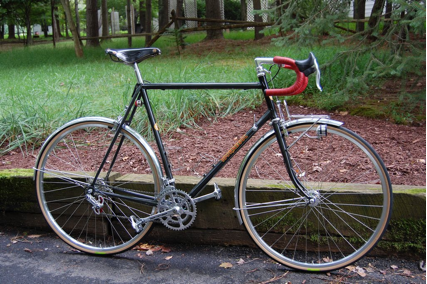This weekend, Austin, Texas hosts the 7th annual North American Handmade Bicycle Show—affectionately known as “NAHBSâ€â€”where many of the worlds finest bicycle and accessory craftsmen will assemble to show their wares, exchange ideas, and in some special cases, maybe enjoy a ride or two.
This year, one of our favorite builders, Steve Hampsten from Seattle, Washington’s Hampsten Cycles, will make the trip, armed with a beautiful array of bikes designed using traditional principles and materials and geared for racers and enthusiasts alike. While you may know Steve more for his brother’s exploits, his framesets are proof that there’s more behind the family name than just legendary Grand Tour victories. You can read Part 1 of the interview here.
I’d be remiss if I didn’t mention Tournesol, your line of traditionally inspired French “constructeur†bicycles. Where does Hampsten end and Tournesol begin?
SH – Tournesol is a project that started with my pal Douglas Brooks wherein we wanted to explore some ideas that seemed pretty separate from Hampsten Cycles. Douglas is involved on some level with Rivendell Cycles and we both have a strong appreciation Rene Herse, Alex Singer, Toei, and Mariposa bicycles: let’s say bicycles built in the tradition of French touring/randonnee/audax bicycles of the 1950s. Typical for this style of bike is that you’ll see a small front rack and handlebar bag, fenders, maybe some dependable lights, and usually a more upright position than on a racing-style bike.
At the same time, my desire was to create a separate visual look for Tournesol, one that pretty quickly communicated that these were not particularly “modern†bicycles, and I wanted to do that through the decals and paint choices. Our vision for Tournesol always involved using a variety of parts – some even going back to the 1950s – and I wanted us to be able to make the bike look as correct whether we were using old Mafac/Simplex/TA or modern Campagnolo/Shimano/SRAM, or, as often happens, a mix of old and new.
Why might someone consider a Tournesol over a Hampsten?
There isn’t really a line of demarcation between one label we sell and the other. We’ve always presented Hampsten bikes as being modern and fairly simple and un-fussy but as the level of complexity goes up—lugged frames (usually), rack, fenders, lights, maybe use of classic or silver parts—then it starts to look more like a Tournesol. But I’m not overly anal about it one way or the other—they do share a lot of the same DNA.
What was the inspiration for the Crema line of non-custom, lower cost framesets?
Crema is predicated on the premise that:
A) – people want a great steel frame and fork
B) – and they need a fender bike
C) – or one for big, fat tires whilst riding on gravel roads
I also wanted to work with the idea of using a size chart and we had some excess tubing sitting around that needed a good home. And finally, I wanted to let out my inner control freak: choose your size, pick a nice color (from four/five),
and we don’t need to waste time discussing tires/fenders/brakes/fork. Probably the biggest impetus was trying to limit my back-and-forth discussion with the customer and to push my favorite bike (all-steel, fendered). And it’s worked!
How do you feel about current industry trends? Do you feel pressure to build a cyclocross frameset or an urban assault fixie?
As I said earlier, we build what we ride and we don’t worry about the rest of it. However, if we were getting requests for the bikes you mention then our scruples may be in danger of being compromised. But no one has asked, no compromises have been made. Straight-edge ‘til death, that’s us.
You’re going away for a year—which bike do you take and why?
Crema in Toyota Silver with S & S couplers, SRAM Force, 3x wheels, Jack Brown tires for exploring and 28mm Roly Polys and Honjo fenders for the day-to-day riding.

